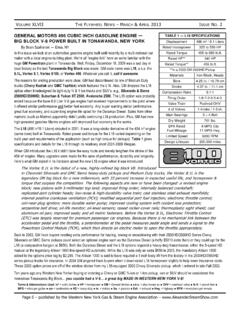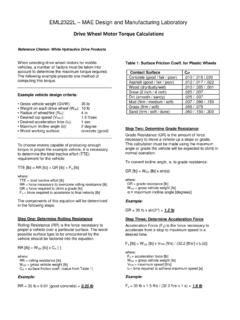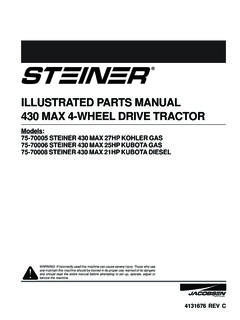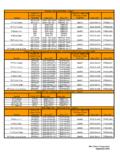Transcription of Chevrolet 8.1l swap into 88 one ton four wheel …
1 Chevrolet swap into 88 one ton four wheel drive by Gary Puls The Chevrolet liter engine was produced from 2001-2006 and installed in HD 2500 and larger trucks and vans, as well as m otor homes, Suburbans and Avalanches. It is similar to previous big blocks, but has the advantages of better cylinder head and intake manifold flow than the earlier liter engine did. It has larger displacement from an increase in stroke. It is factory rated at 340 HP @ 4200 rpm and 455 lb/ft of torque @ 3200 rpm The following chronicles the fabrication and modifications required to install a 2002 liter Chevrolet engine into a 1988 one ton crew cab. The engine has bosses for old and new style engine mounts. You may use your existing engine mounts with this configuration. The bell housing bolt pattern is the same as previous small and big block Chevy s. Note that all fasteners in this engine are metric. The flex plate is unique to the Note the crankshaft sensor, oil pressure sensor, and the EGR valve tubing in the picture, below right.
2 The frame rails on the Silverado pickup (in which these engines came in) are wider than earlier trucks. This creates some clearance issues with the frame, firewall and engine cross me mber. Since the complete frame on this truck was going to be boxed, I decided to use the manifolds that came with the as they are cast out of stainless steel and have the port for the EGR tubing. One could use headers for an earlier big-block, but be sure to check clearances as the uses a tall-deck block. Other wise, the flange bolt pattern is the same as other big-blocks. The frame rails need to be notched, back by the exhaust manifold to flange area, and the top edges of both sides of the frame need to be trim med back to make room for the heat shields. You are removing a fair amount of material, so be sure to box all of this in with 3/16 plate to strengthen the frame. Another clearance issue is the LH front corner of the oil pan. This was corrected by first cutting a hole in the cross-me mber, fabricating a piece out of 3/16 flat stock to fill the hole and welding in.
3 A so me what ma jor clearance issue was the right frame rail. The air conditioning compressor is definitely in the way here. I rem oved the top of the rail to make room to clear the compressor, and the reinforced the outside of the frame to get back the frame thickness I had to remove. Aftermarket accessories, such as those available from Street & Performance will help you avoid these issues. I wanted to keep all of the factory parts for availability issues since this truck will be on the road quite often. I you decide to keep the EGR valve functional, like I did, beware that there is not much clearance between the tubing and the firewall. I later increased this clearance by trim ming the pinch weld. The valve itself had to have some of the cooling fins removed for firewall clearance. I used stock oil cooler lines to plumb in the auxiliary engine oil cooler.
4 I cut the tubing before the factory crimp, next to the rubber section. (These are prone to leakage anyways). I then TIG welded a -10 A-N fitting to the end. This allows high-quality Aeroquip A-N hose and fittings to be used from the pipes to the cooler. These are the fittings that the oil cooler pipes connect to. They are next to the driver s side oil pan rail, in front of the oil filter For the fuel system, I used compression fittings from Street & Performance, which allowed me to adapt from the 3/8 and 5/16 fuel rails to -6 AN. I then bent up stainless steel 3/8 hard lines which run all the way to the fuel cell. One is supply; the other is the return line. Below shows ho w I ran them down the transmission bell housing. Take care to route the lines away from the exhaust. I used a portion of flexible hose between the engine and the frame to allow for flexing as the engine twists. Note where bungs were welded in for the oxygen sensors.
5 Be sure to specify if you are running two or four oxygen sensors when you are having your PCM program m ed. Here is the Street & Performance wiring harness, laid out before installation. Note that all of the connectors are labeled, which makes your job easy. It is truly plug and play . The engine uses drive by Wire throttle control. Shown is the TAC (Throttle Actuator Control) module, and the pedal position sensor (or pedal). The pedal is used on turbo diesel C/K trucks. It bolts directly to the 73-91 Chevrolet truck firewall. Beware the Silverado pedal is a lot less expensive, but does not fit as well. Plug in the tagged connectors into the correct sensors. You might want to get the pigtail and connector close to the sensor as you will want to route them carefully, avoiding sharp corners and each other before you actually plug them in. Plug all of them in when you are satisfied with the fit.
6 Crankshaft Position Sensor. Note: after this truck was running, I found out that in reverse under a load, the engine would s mash the crankshaft sensor into the firewall. GM s replacement has the connector turned 90 degrees which increases clearance and I also bent the pinch weld back to create more room. Manifold Air Pressure (MAP) sensor EGR valve Passenger side O2 sensor Coolant temperature sensor Driver side O2 sensor Driver side coils Injectors Passenger side coils Driver side knock sensor Oil level sensor Passenger side knock sensor Throttle actuator motor Canister purge solenoid Throttle position sensor Mass air flow and manifold air temp sensor Alternator Ca mshaft position sensor Engine ground wire. Make sure the area is clean to bare metal for proper ground Transmission: I used the 4L85E transmission, which is the heavy duty version of the 4L80E, optional on engines. Beware that not all 4L80 s and 4L85 s have an output sensor if they came in a four wheel drive application.
7 Many four wheel drives use the speed sensor on the transfer case output. I found out the hard way and had to disassemble the transmission and install a reluctor ring on the output carrier. If your transfer case has a speed sensor, you still might have to change the reluctor ring if it was for a TBI engine. I used a New Process 205 transfer case. Transmission main connector. Park/neutral/gear switch Input and Output (vehicle) speed sensors Powertrain Control Module and fuse box connections: The Street & Performance harness includes a stand alone fuse box. Mount the box in an area where it will be accessible. Connect the orange wire to the battery and the red wire to a 12V source that provides voltage with the ignition switch in the run and crank position. Other connections out of the PCM connectors: check engine light (connect to the ground side of your bulb), 4K pulse for an electric speedometer (optional), brake switch (connect to the 12V side of brake switch when pedal is not pushed) and tachometer pulse wire.
8 This is the fuel pump relay which can be mounted under the hood or dash. The brown wire provides 12V to the fuel pump This is the ALDL plug which is used to interface with the PCM. Mount it under the dash where it will be easily accessible. This connector plugs into the TAC module which should be mounted under the dash. FUEL SYSTEM I fabricated a fuel tank for this truck that fits inside of the frame rails. I cut out the top of the original tank (around the fuel sender) and welded it into the top of my fabricated tank. You need to fabricate a baffle around the fuel pump to keep fuel at the pump at all times. The sending unit cam e out of a mid 90 s car with fuel injection. I hit the salvage yard and keep digging until I found one that was the depth I needed. I built hard lines out of stainless 3/8 tubing for the fuel supply and return line. The fittings at the fuel rail are compression fittings and were purchased from S&P which allow you to adapt to -6 AN.
9 All lines were flared at 37 degrees and a section of rubber high pressure hose was used to allow for engine move ment. EXHAUS T The exhaust system was fabricated out of 304 Stainless Steel tubing and mandrel bends purchased from Stainless Works. It consists of 2 tubing from the engine exhaust manifolds to the Gale Banks muffler A single 3 tailpipe was fabricated and will exit out of a custom fabricated tip in the rear bumper. Three bolt flanges were inserted in the front pipes to allow easy removal in the case of transmission removal. PCM & AI RBOX MOUN TIN G: This shows the PCM and airbox mock-up. After mocking up the PCM in the cab, and running the engine harness wiring through the firewall, I found out that installing it under the hood was a better option. The factory has them there as well, so brackets and shields are available. Note that I had to cut the resonator off of the air inlet as it interfered with the fan shroud. I epoxied a cover over the hole it left.
10 This is a mock-up. Note that the inlet into the air box is designed to seal to the fender. I will fabricate a duct that ties into the radiator core support to ensure outside air gets to the engine. I chose to install the PCM under hood on the RH wheel house. I fabricated these brackets for the OEM mounts to bolt to and welded them on the wheel house. Air Box mounting: I used the stock battery tray and the OEM air box mounting bracket to fabricate an air box mount. You will have to relocate the battery to the driver s side. Diesels used two batteries so look for a tray on one of them or purchase one form your dealer. AIR COND ITI ONIN G: I purchased the adapters from Doc s Block s (w w ). These allow you to adapt from the Denso compressor to an AN style fitting. After measuring the thread size on the condenser (small hose shown) and the drier (large hose shown), I determined the length of hoses and that the end that treads onto the drier needed to be 90 degrees and the fitting that threads onto the condenser needed to be 45 degrees.







